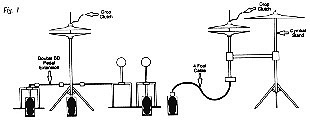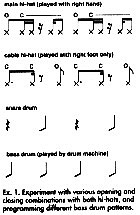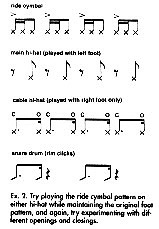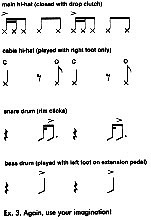Welcome to PaulWertico.com!
Double Hi-Hat Setup
An Alternative Approach
In the last few years drummers have been experimenting with the creative possibilities of using more than one hi-hat. In addition to the conventional hi-hat placed to the left (for right-handed players), drummers also have integrated a permanently closed version-usually placed either in the center or to the right side-in order to play certain grooves without having to cross stick.
With the arrival of the cable hi-hat, drummers now have the added flexibility of using an extension hi-hat that opens and closes. This has been accomplished by putting the cable hi-hat pedal next to their main hi-hat pedal, and positioning the cymbals wherever they feel most comfortable playing them. In this article I'd like to suggest a different setup idea for double hi-hats-one that I've been using for the last 10 years, and that I feel offers a different set of creative options.
Take a look at Fig. 1. You'll notice a couple of variations on the currently popular setup. First of all, my double-bass drum pedal has an extension, thus making it possible for my main hi-hat to stay in its normal position, and the second bass drum pedal to be on the outside. Secondly, you'll notice that my cable hi-hat pedal is next to my primary bass drum pedal. This allows me to play two complete hi-hat setups simultaneously.

This idea came to me long ago when a bass player I knew bought something called a low-boy at a garage sale. The low-boy was an early scaled-down version of the hi-hat that was used in the 1920s. My friend brought it to a rehearsal, and asked if I wanted to play it. I positioned it on the right side of my kit, and soon was intrigued with the sound of two hi-hats being played with both feet. The only problem with the low-boy was its height. It stood only about a foot tall, and was quite impractical for playing with sticks.
A few hears later, Don Lombardi of Drum Workshop came to a Pat Metheny Group concert with his new cable hi-hat. That particular early version consisted of a regular hi-hat bottom that was attached to the top half by a long cable. I immediately took a hack saw to it, cutting the bottom half to an approximate height of 8", so that I could put it next to my bass-drum pedal, and voila: my current setup was born!
I've found a variety of musical situations where double hi-hat pedaling comes in handy. For example, I play quite a bit with various types of sequenced parts, mostly percussion parts or programmed synth lines. But occasionally I play to a bass drum part that's been programmed to play exactly with the bass part. This can be a perfect time to try double hi-hats, since the programmed bass drum part will free up your bass drum foot, and allow you to utilize all four limbs.
There are other times when the music might not call for extensive bass drum work, such as in jazz ballads. Here you can really make use of the two hi-hats-particularly when using brushes-since you can get two different pitched chick and splash sounds. In fact, one of the most interesting double hi-hat applications comes when creating the textural landscapes present in some of modern jazz' more atmospheric moments. Here you can blend cymbal textures with various open and closed sounds of different lengths.
In the context of my setup, I can slide either my right or left foot back and forth between pedals when I need my bass drum. In fact, I've found that by playing patterns with my left foot on the bass drum pedal and my right foot on the cable hi-hat pedal, reggae-type grooves can occur naturally. I use a Drum Workshop hi-hat drop clutch on both hi-hats in case I need one or both of them closed. Then by simply stepping down on the pedals, they open again.
There have even been times when I've used three hi-hats. In those situations I've used my double hi-hat setup, augmented with a third one that was permanently closed, placed in the center of my kit. You also can create interesting tonal environments by attaching tambourine-type devices to one of the hi-hats, or replacing the cymbals with Remo's Spoxe. Anyway, once you try this double hi-hat setup, I think your imagination will take over. But here are a few grooves just to give you the idea (Ex. 1-3).



Images and Information from Drums & Drumming December 1989/January 1990, pages 63 & 65